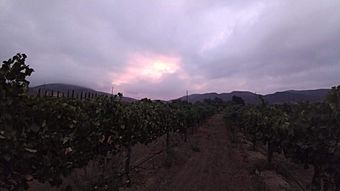Temecula Valley AVA facts for kids
| Wine region | |
 |
|
| Type | American Viticultural Area |
|---|---|
| Year established | 1984 (amended in 1986, 1987, and 2004) |
| Country | United States |
| Part of | California, South Coast AVA |
| Climate region | Mediterranean, Semi-arid |
| Total area | 33,000 acres (134 km2) |
| Grapes produced | Black Muscat, Cabernet Franc, Cabernet Sauvignon, Chardonnay, Chenin blanc, Cinsault, Cortese, Dolcetto, Gamay noir, Gewurztraminer, Malbec, Merlot, Mourvedre, Muscat Canelli, Muscat of Alexandria, Nebbiolo, Orange Muscat, Palomino, Petit Verdot, Petite Sirah, Pinot gris, Pinot noir, Riesling, Roussanne, Rubired, Sangiovese, Sauvignon blanc, Semillon, Syrah, Tannat, Viognier, Zinfandel |
The Temecula Valley AVA is a special area in Riverside County, California, where grapes are grown to make wine. AVA stands for American Viticultural Area. It means the area has a unique climate and soil that are great for growing certain types of grapes.
Contents
History of Temecula Wine
Winemaking in the Temecula area started again in the late 1960s. This happened when Brookside Winery planted new grapevines.
In 1968, Vincenzo and Audry Cilurzo created the first modern vineyard. Around the same time, Mount Palomar Winery was started by the Peter Poole family in 1969. Peter Poole was important because he began planting Mediterranean grape types. He also created the first wine cave in the area.
The first wines from Temecula grapes were made in 1971 by Brookside. Callaway Vineyard and Winery began growing grapes in 1969. They opened the first Temecula winery in 1974. John Poole's Mount Palomar Winery opened in 1975. The Cilurzos opened their winery in 1978.
The United States government officially named this area the "Temecula AVA" in 1984. Later, in 2004, its name was changed to "Temecula Valley AVA." This is the only American Viticultural Area to ever change its name. The Temecula Valley AVA covers about 33,000 acres.
Temecula's Special Climate
The Temecula Valley is about 22 miles from the Pacific Ocean. This closeness to the ocean helps keep the valley cool. As the sun warms the land, cool air from the ocean is pulled inland. This cool air flows through gaps in the coastal mountains. This creates warm, sunny days and cool nights. These conditions are perfect for growing high-quality wine grapes.
The valley's elevation also helps. Temecula vineyards are about 1,200 to 1,600 feet above sea level. The mountains around them are much higher. Cold air collects in these high places at night. This cold air then flows down into the valley. This makes the nights very cool, which is important for grape flavors.
Perfect Soil for Grapes
The soil in Temecula Valley is also great for growing grapes. It comes from broken-down granite. Grapevines need soil that drains water well, and this granite soil does just that. It's a light, sandy soil. This helps the grapes grow with clean, pure flavors.
Types of Grapes Grown
People have been growing wine grapes here since 1966. Wineries grow popular grapes like Chardonnay, Merlot, and Sauvignon blanc. They also grow Mediterranean types such as Viognier, Syrah, and Pinot gris.
The warm climate of Temecula Valley is especially good for grapes like Cabernet Sauvignon and Zinfandel. It's also good for grapes from the Rhône area. However, grapes that like cooler weather, like Pinot noir, don't grow as well here.
Fun for Visitors
The Temecula Valley Wine Country is a very popular place for tourists. Many people also visit the Pechanga Resort & Casino. Because of this, the money spent by visitors in the valley has grown a lot. In 2018, visitors spent over $1.1 billion!
On weekends, the Temecula Valley is a huge tourist spot. There are more than 40 wineries where you can taste wine. Many wineries have large tasting rooms and host events. They are also popular for weddings and live music in the summer. Some offer places to stay, like bed and breakfasts. You can also take vineyard tours, enjoy barbecues, or go on hot air balloon rides.
Two big yearly events are the Temecula Valley Balloon & Wine Festival and the Harvest Wine Celebration.
Protecting the Vineyards
The Temecula Agricultural Conservancy (TAC) is a group that works to protect vineyards. Their main goal is to make sure that land suitable for vineyards stays as vineyards forever. They work with local leaders to keep these areas open and used for growing grapes.
TAC also helps vineyard owners who want to protect their land. They use something called "conservation easements." This means the land can only be used for vineyards in the future. The owner still owns and farms the land, but it's protected. This helps make sure Temecula Valley will always be a wine region.
Temecula Valley Winegrowers Association
The Temecula Valley Winegrowers Association is a group that helps promote wine and grape growing in the Temecula area. They work to make sure the wines and grapes grown here are of high quality.

